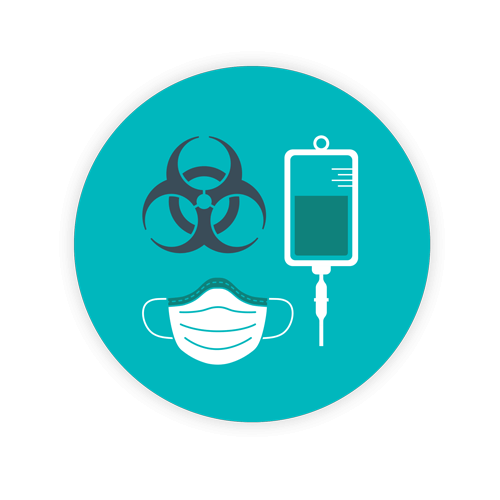Examples of Biohazardous Waste

Navigating the Biohazard Maze | The confusion surrounding biohazard waste
If you’ve arrived at this page, you’re likely asking yourself questions such as “if it comes from a medical facility, is it automatically considered medical waste?” Or, “what’s the difference between biohazard waste or ‘regular’ medical waste? Can it all be disposed of in the same way?” In short, the answer is no. Medical waste is separated into several different categories depending on its type.
Today, we will cover everything you need to know to determine examples of biohazardous waste.
TOPICS WE WILL COVER:
1 / Examples of Biohazard Waste
2 / The Consequences of Improper Waste Segregation
3 / Liquid vs Solid Biohazard Waste
4 / The Challenge of Sharps in Biohazardous Waste
5 / Biohazard Safety Levels: A Closer Look
Examples of Biohazard Waste
 While specific definitions of examples of biohazard waste and biohazard waste disposal may differ slightly in regard to wording, the basic definition of biohazard or hazardous waste is anything that has the potential to cause harm, infection, or contamination of a dangerous agent to humans. Biohazard waste types include:
While specific definitions of examples of biohazard waste and biohazard waste disposal may differ slightly in regard to wording, the basic definition of biohazard or hazardous waste is anything that has the potential to cause harm, infection, or contamination of a dangerous agent to humans. Biohazard waste types include:
Anatomical Waste: From surgical specimens to body parts
This includes specimens or tissues removed during autopsy or surgical procedures that are also suspected of contamination by any infectious agent that may pose a danger to human health. This category is often also referred to as pathological waste or biological waste.
Examples of anatomical waste (or pathological waste/biological waste) include: Body parts, organs, and tissues (skin, muscle, and so forth).
Animal Waste: Managing carcasses, tissues, and fluids
This includes animal tissues, any animal body, or bodily fluids that, like anatomical waste, can potentially contain infectious agents that may pose a risk to humans.
Laboratory Waste: Dealing with infectious microorganisms
Laboratory waste is defined as specimen cultures, bacteria, parasites, viruses, or other microorganisms that increase the risk of contamination, morbidity, or mortality.
Infectious Waste: Blood-related waste and excreta
This is any type of waste that contains human or animal blood, fluids from blood products or components, or objects used in the treatment of animals or humans that may be contaminated with infectious materials. Examples include: Swabs, animal or human tissue waste, and excreta.
Sharps Waste: Needles, scalpels, and more
Sharps waste doesn’t just refer to needles, but scalpels, knives, infusion sets, razor blades, broken glass, and syringes—anything with a sharp edge that has the potential to puncture skin and become contaminated with biological material.
Solid Waste: Contaminated bandages and dressings
Solid wastes can include examples such as bandages and dressings—contaminated waste that has come into contact with blood or other body fluids. This can also include casts contaminated with sweat or fluids such as blood.
Drugs and Pharmaceuticals: From chemotherapy drugs to expired medicines
This category ranges from barium enemas to trace chemotherapy drugs. Cytotoxic (any type of drug that may pose a danger to living cells) drugs commonly used to treat cancers fall into this category. Also included in this category are x-rays and tar-based products.
Pharmaceutical waste may also be included in the above category but, in this case, refers to bottled medicines that are either no longer needed for patient care or expired. Pharmaceutical waste can fall into three subcategories: non-controlled, controlled, and hazardous.
Now, armed with this knowledge, it’s important to ensure you are segregating these waste streams accordingly. If you’re unsure, be sure to check out our deep-dive into biomedical waste segregation guidelines:
BIOMEDICAL WASTE SEGREGATION GUIDELINES
The Consequences of Improper Waste Segregation
Carelessness of waste segregation can result in hefty non-compliance fines or may also increase your cost to be serviced due to unnecessary overclassification.
- Think fast: would you treat bedding materials used by an animal in a veterinary office—potentially infected with a pathogenic organism—the same way you would treat bloody wrappings left on the floor of a trauma unit?
- What about this one: would you dispose of IV tubing that had a needle attached to it the same way you would dispose of surgical waste during an autopsy of a woman who died of natural causes?
- What do you do with a paper towel potentially contaminated with body fluid such as saliva or sweat? It depends, doesn’t it? Was it used to wipe out a petri dish? Or to remove secretions from a human or animal that was potentially contaminated?
If you don’t know how to answer any of these questions, it’s time for a primer on biohazard waste: how it’s defined and the rules regarding its segregation, transportation, collection, and disposal. Contact one of Daniels Health’s medical waste disposal professionals to learn more now:
Liquid Waste vs Solid Biohazardous Waste
Biohazardous waste is also divided into two primary categories: solid and liquid biohazardous waste.
The difference between liquid waste and solid biohazardous waste is thus defined: liquid waste comprises any type of liquid drained or generated from an infected area of the body (animal or human), including cell culture media, supernatant, blood and other bodily fluids.
Federal guidelines and state regulations
The Centers for Disease Control and Prevention (CDC) provides basic information regarding federal guidelines for segregation, collection, and disposal procedures for regulated medical waste – in addition to resources for state regulations. However, all states must follow federal guidelines regarding transportation and disposal.

The Challenge of Sharps in Biohazardous Waste
A primary concern today is the collection and disposal of sharps. And what about sharps container placement? Are sharps considered biohazardous waste products?
Why sharps are considered biohazardous
The simple answer is yes, as sharps can fit under the description of potentially causing harm to humans, especially regarding contaminants and exposure to body fluids, animal or human blood, and pathogens. Sharps must be disposed of properly, lest they end up on the beachfront, which has happened in the past and is a large part of the reason that Daniels Health was founded.
Proper disposal in sharps containers
Sharps of any kind should be properly disposed of in a sharps container placed in convenient and adequate locations to reduce needlestick injury. Any metal sharps waste should not ever be placed in a regular trash can or dumpster.
Any medical waste generator, including those that generate waste containing biohazardous materials, is mandated to adhere to federal and state waste guidelines. If in doubt, err on the side of caution.
To make things a little simpler for you, we have created a Waste Segregation cheat sheet:
Biohazard Safety Levels: A Closer Look
CDC’s four biohazard levels
The Centers for Disease Control and Prevention (CDC) defines four biohazard levels:
- Level I: defined as those that trigger minimal threats to either humans or the environment. Think E. coli.
- Level II: something that is spread through direct contact with some type of infected material that can also cause illness in humans, such as hepatitis B, HIV, and Salmonella.
- Level III: any type of pathogen that has the potential to become airborne and cause a disease. A prime example of a biohazard level III pathogen includes tuberculosis.
- Level IV: any type of a pathogen that triggers risk of life-threatening disease in humans for which we have no treatments today. Consider the Ebola virus.
Daniels Health Is Here To Help
The importance of adhering to waste regulations
There’s a reason medical waste must be properly segregated, and state and federal guidelines should be strictly adhered to so as to prevent the spread of infectious diseases and contamination.
Bottom line: Do you know how to deal with different types of biohazard waste? Do you know federal and state regulations inside and out for the proper segregation and disposal of such waste? With decades of experience in the industry, Daniels Health does.
We promote waste stream segregation methods that keep you in compliance with the added benefit of CO2 emissions reduction and reduced carbon footprint. When it comes to healthcare waste segregation and management, don’t take chances. Call Daniels Health for help setting up a workable and safe healthcare waste management system.
Let's Talk!
Your time is valuable, and we don’t want to play hard to get. You can either phone us directly on the details listed on our contact page, or feel free to fill out this short form and one of our team members will get back to you as quickly as possible.
